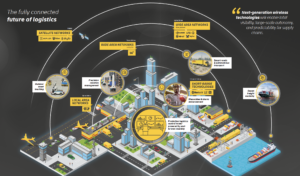For many people around the world, it is hard to imagine life without wireless access to the internet. Alongside food, water, and shelter, Wi-Fi is increasingly seen as a necessity in today’s modern world. Next-generation wireless describes the latest advances in a series of wireless technologies. DHL reports about 5G potential for logistics.
Breakthroughs in existing wireless network technologies and the rise of entirely new networks are accelerating IoT applications in both the consumer and enterprise environments. In logistics, these intelligent networks can enable cost-effective seamless indoor and outdoor connectivity and localization of shipments and assets. The vision of a connected supply chain with complete transparency and traceability becomes more and more tangible.
Technology
Beyond the current hype surrounding 5G, known technologies like Wi-Fi and Bluetooth and lesser-known technologies like low power wide area networks (LPWANs) and low-Earth orbit (LEO) satellites are all making significant progress, advancing capabilities for the modern world. These next-generation wireless technologies are intended to fill the world’s remaining connectivity white spots, shifting online access from the ubiquitous to the universal. To do that, technology must achieve three major objectives: bring everyone online, bring everything online, and deliver connectivity everywhere.
To achieve these goals, next-generation wireless technology must meet a broad variety of user and industry requirements. Networks need to accommodate rapidly rising levels of traffic, as users’ appetite for data-intensive services increases and as billions of new devices for network access. They must operate at higher speeds to support demand from consumers for high-definition video streaming and online gaming.
In enterprises, increasing the use of data analytics and machine learning platforms place greater demands on the collection and processing of data both at the edge and in the cloud. Wireless networks must enable end-users, professional or private, to perform these functions seamlessly and reliably in the busiest cities and the most remote rural communities. Perhaps most importantly, next-generation wireless networks must also support the requirements of IoT systems. These may only need to exchange a few bytes of data in each transmitted message but must do so with complete reliability with minimal power consumption and at the lowest possible hardware cost.
Different end uses require different types of wireless connectivity. To meet the needs of an ever-growing variety of applications, next-generation wireless technologies differ in terms of speed, capacity, power requirements, and, one of the most fundamental differentiators, range. They can be categorized in the following groups:
- Short-range network technologies such as radio frequency identification (RFID), near-field communication (NFC), and Bluetooth connect devices across distances of a few millimeters to several tens of meters. They are typically used for connectivity within the same room or between different parts of a single larger object.
- Local area network technologies such as wireless fidelity (Wi-Fi), light fidelity (Li-Fi), and ultra-wideband (UWB) connect devices across distances of a few meters to a few hundreds of meters. They are typically used to provide coverage across a specific area, such as a home, office, warehouse, or factory.
- Wide area network technologies such as 5G, Sigfox, LoRa, LTE-M, and NB-IoT connect devices across distances of a few hundred meters to several hundred kilometers. They are typically used to provide coverage at a regional or national level.
- Global area network technologies, involving low-Earth orbit and geospatial satellites, connect devices across large parts of the Earth’s surface. They are typically used to provide connectivity in remote locations and to maintain a connection to devices that may travel long distances in ships and aircraft.
The DHL report presents many use cases for 5G in supply chains, transport, and warehousing.
Smart Roads and Logistics Transport
Initiatives to enable highways and transportation infrastructure with 5G are already underway today. Smart mobility solutions such as 5G connected traffic control systems will help to reduce road congestion, making journey times shorter, more predictable, and more fuel-efficient.
Chinese network carrier China Mobile has developed city-scale plans for 5G road networks within Hubei province that are capable of supporting cellular network coordinated transportation services. The first use can be seen with 5G toll booths that allow for automated toll collection without slowing down traffic or requiring any toll workers. As well as ushering in new levels of connectivity and visibility for logistics, 5G technology will be a key building block in the development of autonomous driving systems for trucks especially in the case of platooning and long-haul transport.
Planning Pop-Up Logistics Facilities
Dynamic Pop-Up Logistics Facilities Retailers and supply chain leaders are embracing trends towards faster delivery, urban fulfillment centers, and a longer peak season every year-end. This puts increased pressure on the capacity of logistics facilities, both physically and digitally. After building fit-out, staffing up, and process engineering in any new logistics facility, it remains costly and complex to deploy wireless network infrastructure. 5G offers the potential to reduce setup costs and simplify the management of logistics facilities.
Read the full DHL report here.

